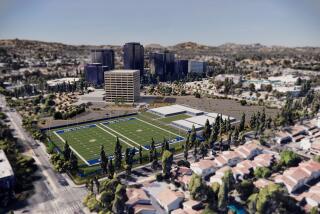In Victory for Detroit, GM to Move Downtown
- Share via
DETROIT — In a boost to this city’s troubled downtown, General Motors Corp. announced Thursday that it has purchased the landmark Renaissance Center and will establish its world headquarters there.
With the move, GM fulfills both business and social objectives. It allows the consolidation of the company’s far-flung administrative offices in one place while boosting efforts to revitalize Detroit’s threadbare downtown.
GM--the world’s largest auto maker, with 1995 revenue of $169 billion--acquired the mirrored-glass office and hotel complex known as the RenCen from Highgate Hotels, a Texas investment firm that had recently bought it.
The RenCen’s largest tenant now is Ford Motor Co., which has about 2,000 employees there and a lease that runs to 2005. But with GM planning to put its logo on the building, Ford is expected to begin looking elsewhere.
Ford’s late chairman, auto heir Henry Ford II, was the prime mover in the mid-1970s development of the Renaissance Center, an elaborate but unsuccessful effort to revitalize a city whose image and economy were badly damaged by riots in 1967.
GM’s purchase price was not disclosed, but real estate sources put it at about $75 million, a figure the auto maker did not dispute. That’s a small fraction of the $350 million the complex cost in 1976, an indication of how far commercial values have fallen in Detroit in the last two decades. The complex has been through at least two bankruptcies.
“It was a pretty good deal,” said Harry Pearce, GM’s vice chairman.
The RenCen, situated on Detroit’s waterfront overlooking Windsor, Canada, was bogged down by cost overruns and became a financial morass for its investors, which included Ford, GM and a handful of insurance companies. Few other spinoff projects materialized.
The transaction is a major coup for Mayor Dennis Archer, who was elected three years ago with a promise to rebuild a city that was crumbling under the weight of social ills and financial abandonment.
“With the purchase, GM reaffirms that Detroit offers what it takes to be a world headquarters city into the 21st century,” Archer said.
Pearce said GM’s commitment to stay in Detroit was predicated in part on Archer’s strong leadership. Archer has reached out to suburban businesses, while winning approval for a $235-million downtown baseball stadium and attracting federal redevelopment funds.
“We felt we had a social responsibility to see that the mayor’s vision would become a reality,” Pearce said.
GM is the only one of the Big Three auto makers whose headquarters is still in Detroit. However, most of its top executives now work out of offices in Warren, a Detroit suburb where the company’s sprawling technical center is located.
The company will vacate its current headquarters in the city’s New Center area just north of downtown. The Art Deco building, designed in 1920 by architect Alfred Kahn, is a national historic landmark.
GM considered refurbishing the aging structure but said the cost would have been greater than buying the larger RenCen. GM vowed to work with the city to attract a new owner or tenants to the venerable building, whose 15th-floor executive suite has been the setting for some of industrial America’s most memorable decisions.
While a boon for downtown, GM’s move will be a blow to its current neighborhood, a commercial and residential area that has undergone redevelopment but is surrounded by urban decay.
The RenCen, designed by architect John Portman, consists of a 73-story cylindrical hotel tower with 1,392 rooms and four 39-story office towers with 2.1 million square feet of space. Current occupancy is 83%. GM said it will begin moving in almost immediately and will eventually fully occupy the four office towers.






